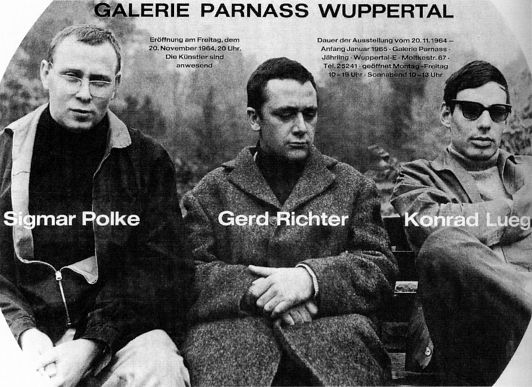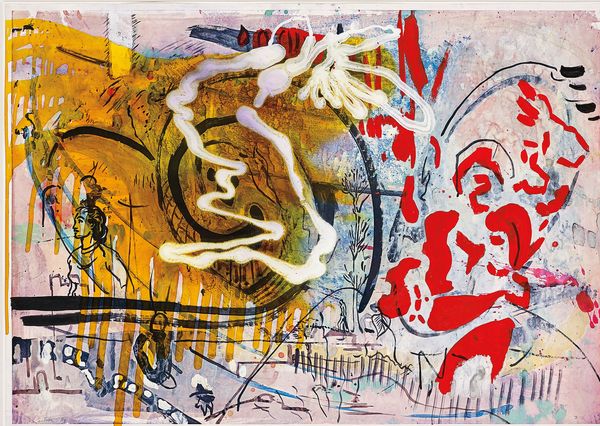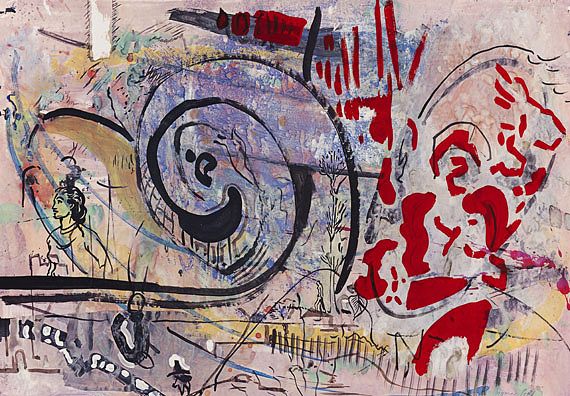Konrad Lueg, Sigmar Polke, Blinky Palermo and Gerhard Richter in front of Galerie Heiner Friedrich, Cologne, 1967
The bedrock of Sigmar Polke's artistic ideals is the legacy of growing up in the German Democratic Republic (GDR), followed by the sudden sensory overload of consumer culture after moving to West Germany in 1953. It was on the cusp of this literal and cultural divide that Polke studied at the Kunstakademie, Düsseldorf under the tutelage of Joseph Beuys, and alongside Gerhard Richter and Konrad Lueg. Here, under the twin influences of Dada and the newly founded Fluxus movement, it became natural for these artists to experiment with producing utterly unacademic works under the banner of "Capitalist Realism": an artistic movement referencing both the state-ordained Socialist Realism across the Iron Curtain, and its antithesis in the West, the abstract art of the 1950s.
Together, these artists responded to the nationalistic themes of the GDR while also critiquing West Germany's burgeoning consumer society. Although the movement was sometimes referred to as "German Pop," its proponents were more skeptical and anarchic than their American cousins.
Advertisement for a Polke, Richter and Lueg show at Galerie Parnass Wuppertal
The roots of Polke's artistic mockery lay in the hardships of post-war Germany, and he continued this ideologically motivated critique of consumer society throughout the 1960s and '70s. By opening his artistic ideas to influences from Pop Art and 1950s abstraction, but also Dada and Fluxus, Polke developed a variability that made him a Postmodern artist ahead of his time and allowed him to move freely between "high art" and vaudeville. Although he pilfered the same source material as his American Pop cousins (Roy Lichtenstein, Andy Warhol and Claes Oldenberg), their manipulations were in stark contrast. Where the American artists purged the commercial fliers and tacky small-ads of tawdriness and lent them a cool, oversized grandeur through cropping and enlarging, Polke instead relished in the dross and incorporated it into his work. Unafraid to embrace the tenets of "bad taste," Polke imbued his work with the ugly, the sublime, the uncanny, but also the banal and of course, kitsch. He created, as Martin Hentschel described, an "irreverent, carnivalesque response to modern progress and its promises."
When I came to the West, I saw many, many things for the first time. But I also saw the prosperity of the West critically. It wasn't really Heaven. – Sigmar Polke
Polke's resulting carnival of imagery included the motifs of furnishing fabrics found in petit-bourgeois sitting rooms: palm trees, leopard spots, flamingos and flowers, alongside "German" things like sausages and potatoes (the latter being a particular favorite of the artist). He used a plethora of stable and unstable pigments in his work: photographic silvers, raw materials and paints that change color so that his work is always a dialogue between order and disorder. Polke's art is dedicated to heterogeneity: multiple perspectives and multiple forms of ambiguity; and this is clearly demonstrated in this lot from Evening & Day Editions: Untitled [Mönchengladbach, 1983].
Sigmar Polke Untitled [Mönchengladbach, 1983]
From a series produced in 1983 as a New Years gift for the Museumsverein in Mönchengladbach, this unique work is based on a gouache of the same image from which thirty offset lithographs were produced, before unique hand-overpainting in varnish and acrylic paint was applied by Polke. The final works were addressed to the connoisseurs associated with the museum director and Polke expert, Dierk Stemmler, who had introduced his museum's public to some difficult works by the artist. Polke's gift to these supporters is a sumptuous, dissembled pictorial surface. Existing almost as a sketch, despite following instead of preceding the gouache, the overpainting allowed Polke to continue experimenting with layers of pigment over a disjointed, surreal composition.
A version of Sigmar Polke's Untitled [Mönchengladbach, 1983], without hand-coloring
Throughout his printmaking career, Polke dedicated significant attention to the medium of offset lithography, despite it being a technique which, at the time, was not considered original printmaking at all because the artist has no direct involvement in the printing of the work. Even now, it is often considered a utilitarian, industrial reproductive process; and, yet, therein lay its attraction for Polke, as a technique free from the mystique or, as Walter Benjamin decried it, the "aura" of an artwork.
In Untitled [Mönchengladbach, 1983], Polke uses the offset lithography method to reproduce his own work, instead of borrowing from source material, before applying freehand drips of viscous yellow varnish and a meandering path of white acrylic. We are beckoned to see the phantasmagoria of his composition which dissolves under layers of translucency, belying Polke's training as a stained glass worker in his youth.
Through the hand-applied pigments, the sketchy hints of landscape and figures can only be guessed at, rather than pieced together. Instead of using color and texture to layer visual spaces and create perspective, Polke instead embeds his imagery at the surface, frozen in an amber plane and buried under white caulk. The limited pictorial elements deduced from the picture's surface are endowed with a weightless quality, suspended somewhere between reality and imagination.



